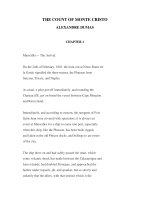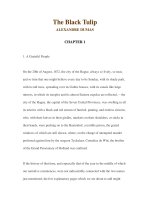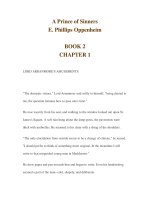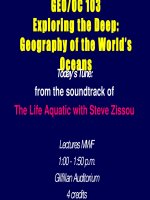Coastal Lagoons - Chapter 1 ppsx
Bạn đang xem bản rút gọn của tài liệu. Xem và tải ngay bản đầy đủ của tài liệu tại đây (192.66 KB, 5 trang )
Introduction
I. Ethem Gönenç and John P. Wolflin
CONTENTS
1.1 Background: Issues and Approach
1.2 Purpose of the Book
1.3 Overview of Topics
1.4 The Future
1.1 BACKGROUND: ISSUES AND APPROACH
Lagoons are the most valuable components of coastal areas in terms of both the
ecosystem and natural capital. Surrounding areas of lagoons provide excellent oppor-
tunities for agriculture and tourism sectors on the one hand and for fishery and
aquatic products sectors on the other hand. Sustainable use management is a con-
scious social decision that provides for the long-term health of both the ecological
and economic systems of a lagoon and surrounding areas. However, the concept of
sustainable management of lagoons is often either not clearly understood or not
applied.
The NATO Committee on the Challenges of Modern Society (CCMS) study was
initiated in 1995 to define and promote sustainable use management in lagoons. The
focus was on integrating management decisions with current modeling methodolo-
gies. This book,
Coastal Lagoons: Ecosystem Processes and Modeling for Sustain-
able Use and Development,
is a product of this NATO-CCMS study.
Coastal lagoons are shallow aquatic ecosystems that develop at the interface
between coastal terrestrial and marine ecosystems. They are driven to a major extent
by the high density of noncommercial auxiliary energy and mass exchanged with
the surrounding ecosystems. The rate of structural and functional change of hydro-
geomorphological units and biological communities is particularly dependent on
the exchanges of auxiliary energy and mass. Although lagoons are intricately con-
nected to surrounding environments, they develop mechanisms for structural and
functional regulation, which result in specific biological productivity and carrying
capacities.
Continental and marine environments influence coastal lagoons by definition of
location. Historically, coastal regions have been areas prone to human habitation.
The resulting rural and urban landscapes reflect human orientation toward the use
of the natural capital of lagoons. Lagoons are sensitive areas that play an important
1
L1686_C01.fm Page 1 Monday, November 1, 2004 3:27 PM
© 2005 by CRC Press
role among the coastal zone ecosystems as they provide suitable breeding areas for
many species. Today many lagoons are deteriorating because of overuse of their
natural capital. Fisheries and aquaculture, tourism, urban, industrial, and agricultural
developments are typical uses that are not only uncontrolled but also competing.
The result is that the existing quality and future ability to sustain the productivity
of natural capital is being compromised. The environmental deterioration can be
characterized by dissolved oxygen deficits, aquatic toxicity, variation in organism
structure, disappearance of benthic animals, turbidity and odors, fish mortality,
sedimentation, and clogging of channels. These problems hinder future use of the
lagoons and surrounding environments and lead to loss of agriculture, fisheries, and
aquatic production as well as hinder tourism.
The loss and deterioration of coastal environments are being recognized. More
than 30% of the special protection areas designated under the European Union
directives for conservation are coastal and many NATO and EAPC countries have
developed a considerable body of protective legislation in recognition of the value
of coastal environments. Therefore, special emphasis must be given to the concept
of sustainable use management in decision making on the use and development of
the natural capital of coastal areas.
1.2 PURPOSE OF THE BOOK
This book suggests a basic framework for making informed decisions and taking
positive actions for the sustainable management of lagoon systems. The individual
chapters present the current status of available information on lagoon systems
and models that describe the processes and mechanisms of the interrelationships
and energy flow within a lagoons systems. The data and models are useful for
demonstrating the cause and effect relationship of changing input variables to
predict the alternative future outputs for a lagoon ecosystem. They form the basis
for decision-making. It is suggested that a decision support system should be
established and maintained on a continuing basis in order for sustainable man-
agement decisions to be effectively integrated into the socio-economic system
influencing the natural lagoon system.
It must be recognized that many decisions will be made temporally (over a
time scale) and spatially (across a wide geographic area and diverse societal
infrastructure units and levels) that affect each lagoon. It is critically important to
provide the best available knowledge and information in a coordinated way to
result in decisions that foster the sustainable management of these threatened
coastal systems. It is the task of decision makers to make choices that affect the
lagoon system using the best available information and tools. These decisions
inevitably center on finding the balance between the finite capacity of the lagoon
system and the many demands being placed upon it by the socio-economic system
that depends on it. Further, it is imperative to establish a process or plan by which
informed decisions can be made over time, and which provides consistency and
ensures coordination by the multitude of “users” of the lagoon system about the
future of the lagoon.
L1686_C01.fm Page 2 Monday, November 1, 2004 3:27 PM
© 2005 by CRC Press
This book focuses on the issue of sustainable use and promotes modeling as a
tool for decision making in the context of the following:
1. Developing and improving the concept of hierarchical organization of
physical, chemical, and biological environment, which promotes under-
standing of a holistic or ecosystem approach to management for sustain-
ability of natural capital in the coastal lagoon management
2. Positioning of the lagoon systems within the hierarchy
3. Establishing the structural dynamic models as a crucial step for research,
monitoring, and integrated management programs of coastal lagoons
4. Selecting scientific achievements relevant for policy makers, planners, and
practitioners working in the field of sustainable management of the
lagoons and land/seascapes to whom they belong
5. Unifying a conceptual and operational framework for ecosystem modeling
of coastal lagoons
6. Integrating sustainable use management principles into the decision-mak-
ing process temporally and spatially
1.3 OVERVIEW OF TOPICS
The following guidance is provided to inform readers from various disciplines
and professional work areas about the various topics discussed in the individual
chapters of this book. As noted above, Chapter 1 briefly identifies the focus of
the book.
Chapter 2 provides the overall framework for the rest of the chapters. This chapter
defines the organization and functional structural specifications of lagoons. A phi-
losophy of sustainable management is related. The processes of transport, bio-
geochemical cycle, and ecology are described, and the challenges of modeling in
lagoon environments are discussed. Chapter 2 is highly recommended for decision
makers and managers because it is an overview of the key issues that should be
considered in management.
Chapter 3 reviews the physical processes that drive transport in lagoons. Equations
for defining mass, momentum, and energy transfer are presented along with equations
for determining temperature, salinity, and sediment transport. Finally, required input
and boundary conditions and the boundary processes are discussed for lagoon eco-
systems. This material is intended for physical scientists. It presents the reader with
an excellent background on physical modeling of lagoons.
Chapter 4 consists of detailed reviews on biogeochemical cycles (nutrients and
organic chemicals) in lagoons and related processes and mechanisms, special con-
ditions that impact these processes and mechanisms, and the equations used to
formulate these concepts. This information is a sound tool for nutrient and toxic
modeling studies. This chapter is strongly recommended to readers with a particular
interest in understanding the internal dynamics of the lagoons, the impacts of inputs
from the socio-economic system into a lagoon, and the evaluation of lagoon carrying
capacities.
L1686_C01.fm Page 3 Monday, November 1, 2004 3:27 PM
© 2005 by CRC Press
Chapter 5 outlines the changes in lagoons under different eutrophication states
and morphologic conditions regarding main biological features and processes. The
chapter provides a framework for ecological modeling studies. The targeted readers
for this chapter are those who have a specific interest in assessing the trophic state
in lagoons by a structural analysis of producers and consumers, as well as changes
that result from the impacts of socio-economic inputs into the lagoon environment.
Chapter 6 presents valuable information on premodeling analysis and model
selection, critical considerations for model implementation, stability and accuracy
problems of numerical modeling, and model analysis. This chapter is recommended
as a reference guide for experienced modelers.
Chapter 7 reviews the principles of developing a lagoon monitoring system as
the first step toward modeling and management. The relationships between moni-
toring and modeling and guidance on evaluation of the monitoring results are
discussed. This chapter is intended as a common reference for all readers.
Chapter 8 discusses decision-making processes. A thorough assessment of how
modeling and other tools should be employed in integrated sustainable use manage-
ment for a lagoon is presented. This chapter should be reviewed in the context of
the information presented in the book prior to this chapter. The mission of this book
and the pilot study is accomplished only if the information and knowledge presented
in this chapter are used. This chapter is required reading for elected officials,
managers, and decision makers.
Chapter 9 consists of selected case studies from different areas of the world.
They provide detailed information and knowledge on how to apply the methodolo-
gies and approaches given in the book and how to use tools for sustainable use
management of lagoons.
Naturally, readers from various disciplines involved with different aspects of
lagoon assessment and management may not need to absorb information provided
in every chapter in full detail. Readers who study lagoon hydrodynamics should
focus on Chapters 3 and 6. Those interested in lagoon ecology will find Chapters
2, 4, and 5 of value. Finally, readers interested in lagoon management will find
relevant information in Chapters 2 and 8, and other chapters, as necessary. Chapters 1
and 7 are intended for all readers.
1.4 THE FUTURE
Backed by NATO-CCMS, scientists, operators, managers, and students from a wide
geographic range encompassing Central Asia, Europe, and North America have
contributed to this book. They reunited annually for workshops in contributing
countries to study lagoons for a 5-year period. These workshops enabled the partic-
ipants to test the reliability of the information provided in the chapters of this book
for the targeted purposes outlined above. Contributors from different disciplines and
with different levels of background shared information, made arguments, investi-
gated lagoons, and together developed the common vision and understanding
reflected in this book.
L1686_C01.fm Page 4 Monday, November 1, 2004 3:27 PM
© 2005 by CRC Press
At the beginning of the new millennium, countries at all stages of development
are aware that environmental pollution must be managed, particularly in coastal
areas. The international team of expert scientists who contributed to this book
appreciate your attention and wish you well as you continue on the path of designing
and implementing sustainable use management strategies.
L1686_C01.fm Page 5 Monday, November 1, 2004 3:27 PM
© 2005 by CRC Press









